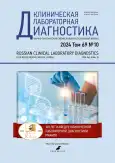Проблемы внедрения единой городской лабораторной информационной системы
- Авторы: Мудров В.П.1,2, Ефимушкина О.А.2
-
Учреждения:
- Российская медицинская академия непрерывного профессионального образования
- Городская клиническая больница № 52
- Выпуск: Том 69, № 10 (2024)
- Страницы: 306-313
- Раздел: Оригинальные исследования
- Статья опубликована: 28.02.2025
- URL: https://kld-journal.fedlab.ru/0869-2084/article/view/653989
- DOI: https://doi.org/10.17816/cld653989
- ID: 653989
Цитировать
Полный текст
Аннотация
Обоснование. В развитии клинической лабораторной диагностики во всём мире взято направление на централизацию лабораторных исследований. Централизованная лабораторная информационная система на основе облачной технологии представляет собой единую базу данных с обеспечением синхронизации данных между различными клинико-диагностическими лабораториями и возможностями по подготовке любых видов консолидированной отчётности. Выбор платформы единой Лабораторной информационной системы (ЛИС) для общегородского использования с возможностью тиражирования на все лаборатории города с учётом экономичности, адаптивности, работоспособности, простоты интеграции с другими IT-медицинскими продуктами города среди имеющихся систем обусловил решение о создании новой единой лабораторной информационной системы для всех лабораторий Москвы.
Цель — обобщение опыта внедрения единой региональной (городской) лабораторной информационной системы в условиях многопрофильной медицинской организации.
Материалы и методы. Департаментом здравоохранения Москвы была предоставлена ЛИС «Эфир» на основе облачной архитектуры с едиными справочниками. Для координации действий при выполнении проекта была создана рабочая группа из ответственных сотрудников клинико-диагностической лаборатории № 1 и специалистов Департамента здравоохранения Москвы по внедрению ЛИС. Учёт рисков при переходе с одной ЛИС на другую и предпринятые превентивные меры минимизировали возможные риски при переключении.
Результаты. Переход на другую ЛИС без остановки лабораторного процесса, снижения объёмов тестирования и при сохранении сроков выдачи результатов привёл к росту нагрузки на персонал лаборатории. Это повлекло за собой увеличение количества несоответствий, однако ситуацию удалось стабилизировать и не только вернуть первоначальный процент брака, который составлял 2–2,5%, но и снизить его до 1%.
Заключение. В результате внедрения ЛИС Городская клиническая больница № 52 получила современный и надёжный инструмент управления работой всего лабораторного комплекса. Процесс внедрения превзошёл ожидания, что было подтверждено всеми участниками проекта. Проект внедрения ЛИС «Эфир» был успешно реализован. Полученный опыт может быть использован в других медицинских организациях города.
Полный текст
Об авторах
Валерий Павлович Мудров
Российская медицинская академия непрерывного профессионального образования; Городская клиническая больница № 52
Автор, ответственный за переписку.
Email: vpmudrov@yandex.ru
ORCID iD: 0000-0003-1129-8335
SPIN-код: 4934-3745
д-р мед. наук
Россия, Москва; МоскваОксана Александровна Ефимушкина
Городская клиническая больница № 52
Email: kdl9312@gmail.com
ORCID iD: 0000-0002-9215-2719
канд. мед. наук
Россия, МоскваСписок литературы
- Latypova MF, Shamanskij MB, Makarov VV, et al. Centralized laboratory information systems: the expediency and attractiveness of a single nomenclature of clinical laboratory research. Spravochnik zavedujushhego KDL. 2016(12):15–32. (In Russ.) EDN: XEKFPR
- Gascón F, Herrera I, Vázquez C, et al. Electronic health record: Design and implementation of a lab test request module. International Journal of Medical Informatics. 2013;82(6):514–521. doi: 10.1016/j.ijmedinf.2013.03.006
- Ilyin AV. Implementation experience of laboratory information management system in a single information complex. Laboratory Service. 2016;5(4):46–49. doi: 10.17116/labs20165446-49
- Panfjorova IS, Makarova IV, Kurbatov AV. Laboratory information system. A reasonable choice and reasonable requirements. Spravochnik zavedujushhego KDL. 2018;9:57–65. (In Russ.) EDN: YSXCZF
- Latypova MF, Cibin AN, Ivanushkina OI, et al. Current legal regulations for information systems in laboratory medicine. Spravochnik zavedujushhego KDL. 2017;10:67–79. (In Russ.) EDN: ZSWNND
- Andrjukov BG, Andrjukov IB, Gel’man EA, et al. Experience creation and implementation of laboratory information systems in the practice clinical diagnostic laboratories the multidisciplinary departmental medical centers. Marine Medicine. 2017;3(1):34–41. doi: 10.22328/2413-5747-2017-3-1-34-41
- Gadzhieva OA, Bashirjan BA. The experience of integrating LIS and CIS EMIAS in the N.N. Burdenko National Research Center of Neurosurgery of the Ministry of Health of the Russian Federation. Poliklinika. 2023(4–1):16–19. (In Russ.) EDN: ESOWGI
- Gajdukov AI, Miheev VV, Polujektov SV. Laboratory information system 1C: Medicine. The clinical laboratory is the basis of the information infrastructure of the laboratory service of the region. Poliklinika. 2019;(6):56–59. (In Russ.) EDN: PNTXYV
Дополнительные файлы










